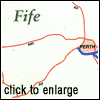|
Culross

Culross once was one of Scotland's major trading ports
due mainly to the enterprises of one man, Sir George Bruce, a sixteenth century coal
and salt merchant as well as a descendant of Robert the Bruce.
The 'palace', situated to the left of the main square,
was built for Sir George and his family in 1577. The structure reflected the wealth
Bruce had accumulated through his local colliery along with the simultaneous production
of coarse salt. In more recent times, Culross Palace was bought a year after the
National Trust for Scotland was formed in 1932 for the amazing sum of £700.
The Town House or Tolbooth is the rather striking
dark stone building overlooking the village entrance. The double staircase approaching
the doorway augments its clean cut, rather austere sandstone outline. Built in 1526,
with the tall tower adjoined a century and a half later, this is now the offices
of the National Trust in this area and also the town's tourist information centre.
James VI had made Culross a Royal Burgh in 1588 but
by the late nineteenth century it was too poor even to pull down its own crumbling
buildings. This turned out to be the National Trust's and the nation's good fortune.
The Trust bought 'the Study' along with nine other buildings for a total of £168.
The cobbled streets climbing toward the Town Square and Merkat Cross, reveal a protruding
piece of early seventeenth century architecture, a lofty apartment called the Outlook
Tower. This is in fact 'the Study' where the Bishop of Dunblane set out his manuscripts
during visits to the then important burgh. Inside are finely preserved painted ceilings
and panelled walls along with a small museum exhibiting local objects and maps of
the period.
 Further up the hill behind the council houses are the remains
of Culross Abbey. In 1217, monks who were the first to mine the coal along the shores
of the River Forth founded this Cistercian abbey. There is little left of the main
abbey buildings but the choir and tower are now the site of the Parish church which
itself dates back to 1300, although rebuilt in 1633. Inside you will find an alabaster
bust cast in memory of Sir George Bruce. Further up the hill behind the council houses are the remains
of Culross Abbey. In 1217, monks who were the first to mine the coal along the shores
of the River Forth founded this Cistercian abbey. There is little left of the main
abbey buildings but the choir and tower are now the site of the Parish church which
itself dates back to 1300, although rebuilt in 1633. Inside you will find an alabaster
bust cast in memory of Sir George Bruce.
On Fife's western-most boundary, the town of Kincardine
is a convenient crossing point of the River Forth. Like so many other towns in Fife,
Kincardine has many buildings showing a Dutch influence. It also shares with several
of the Kingdom's coastal burghs, an industrial heritage based around salt-panning.
|


